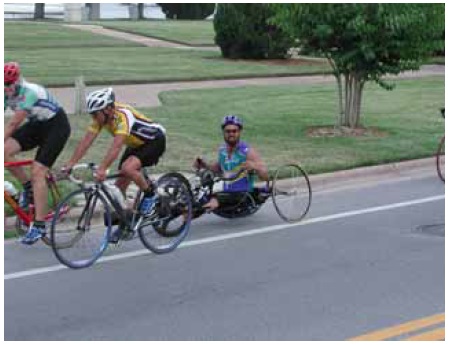Minimum Green Times

Figure 49. A hand cyclist.
The AASHTO equation addresses three factors in its calculation of minimum green time for signalized intersections: perception-reaction time, acceleration time, and travel time at the design speed. Perception-reaction time is assumed to be 2.5 seconds. The AASHTO equation assumes a constant acceleration rate; however, this research shows that the assumption is not accurate. After an initial increase to the acceleration rate, the rate decreases with increasing speed. Rather than produce an equation that compensates for the change in acceleration as speed increases, a table format has been used to represent the distance traveled as a function of time. Further, as many users were on "long" devices (for example, recumbent bicycles had an 85th percentile length of 208 cm (82 inches)), the length of the device is included in the travel distances in table 21 so that the times shown include the time that it takes for the user to accelerate from a stop and completely clear the length of his/her device from the intersection.
Hand cycles are the critical users to consider when determining the appropriate minimum green times for vehicular devices (table 11, figure 49).
Table 11. 85th percentile elapsed time (sec).
| USER TYPE | N | DISTANCE TRAVELED | |||
|---|---|---|---|---|---|
| 12.2 m | 24.4 m | 36.6 m | 48.8 m | ||
| Bicycle | 122 | 4.8 | 7.7 | 10.3 | 12.7 |
| Hand cycle | 33 | 6.6 | 10.6 | 14.6 | 17.9 |
| Inline skates | 21 | 4.7 | 7.6 | 10.4 | 12.8 |
| Kick scooter | 11 | 4.7 | 8.0 | 11.4 | 14.8 |
| Manual wheelchair | 9 | 8.1 | 15.4 | 22.8 | 30.0 |
| Recumbent bicycle | 6 | 3.3 | 6.1 | 8.5 | 9.7 |
| Segway | 4 | 4.5 | 7.8 | 10.7 | 13.9 |
| AASHTO calculation | 5.2 | 9.8 | 11.4 | 12.8 | |
| Pedestrian clearance | 10.0 | 20.0 | 30.0 | 40.0 | |

User Comments/Questions
Add Comment/Question